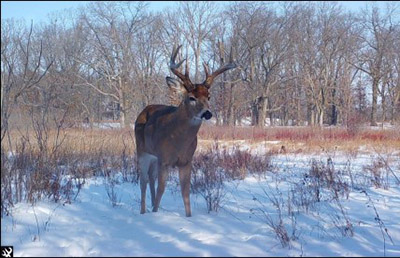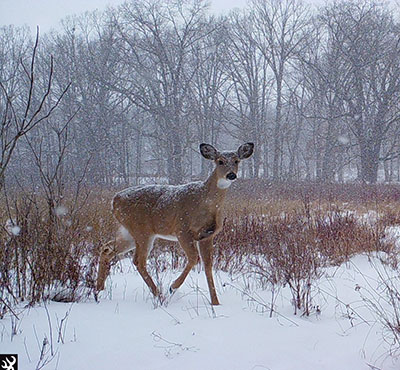Researchers Study Deer-Vehicle Collision Reduction Method
It is in the vested interest of both humans and wildlife to reduce potential traffic collisions. Researchers in the Purdue Department of Forestry and Natural Resources and with the Indiana Department of Natural Resources looked at one possible option to do so in a five-year study involving the development and use of deer-reduction zones, areas where targeted recreational hunting was utilized to reduce animal-vehicle collisions.
The interdisciplinary research group recently published its findings in Science of the Total Environment. Along with lead author Zackary Delisle, a 2023 PhD alumnus, and Dr. Rob Swihart, professor emeritus of wildlife ecology with Purdue FNR, the research team included Carson Reeling, an associate professor with the Purdue Department of Agricultural Economics, Indiana state deer project leader Joe Caudell and 2018 PhD alumna Emily McCallen, a wildlife biometrician with the Indiana DNR Division of Fish and Wildlife.
“The initial goal for this research was to test a method for decreasing deer-vehicle collisions (DVCs) throughout Indiana,” Delisle said. “DVCs are quite frequent in Indiana. From 2003 to 2022, there were more than 300,000 reported DVCs in Indiana, with estimated costs to society of more than $2.5 billion dollars! Therefore, discovering a way to decrease the number of DVCs is important for deer management in Indiana.”
throughout Indiana,” Delisle said. “DVCs are quite frequent in Indiana. From 2003 to 2022, there were more than 300,000 reported DVCs in Indiana, with estimated costs to society of more than $2.5 billion dollars! Therefore, discovering a way to decrease the number of DVCs is important for deer management in Indiana.”
Researchers initially studied the activity of deer in delineated research units across the state, the findings of which are available in an article titled “Deer activity levels and patterns vary along gradients of food availability and anthropogenic development,” published in Nature’s Scientific Reports. The study examined the relationships between animal activity and the availability and quality of food, proximity to human development and other factors, utilizing trail cameras to sample more than 1,000 unique locations during the winters of 2019, 2020 and 2021.
“In that paper we found that deer in the northeast region of Indiana (what we called RMU 9) spend more of the day active than in other regions we studied,” Swihart explained. “Because traffic volume also tends to be higher during the day, deer in this region presumably are more likely to collide with a car. In the northeast region, we specifically estimated deer to be more active in the morning and less active at night, unlike the other regions.”
The publication summarizes the results:
"If animals either are active during a greater fraction of each day or shift their activity to coincide with periods of peak vehicular traffic volume, the chances of animals and vehicles colliding on the landscape likely will increase. In our study, we documented in RMU 9 the highest regional activity levels and a pattern characterized by a greater fraction of activity during the morning rush hours. Under such conditions, accidents involving collisions between motorists and deer might be expected. Indeed, deer-vehicle collisions occur at a rate 1.98 times higher in RMU 9 compared to RMU 3 and 4. Therefore, quantitative examinations of the relationships between characteristics of activity distributions and deer-vehicle collisions may help future management planning to reduce collisions. If positive relationships are found, incentivizing humans to hunt deer in close proximity to roadways may reduce occurrence of deer-vehicle collisions by causing deer to shift to nocturnal activity patterns, reduce movement rates, or select areas further from roads."Based on the results of the initial study, researchers tested how well policies designed to increase human hunting of deer (longer hunting seasons and increased harvest limits) reduced deer-vehicle collisions along 618 kilometers (or 384 miles) of high-risk roadways, or those in the upper 99th percentile in terms of DVCs.
Of the 51 selected roadways covering 949 km, relaxed hunting regulations were implemented among 15 of them, designated as treatment deer reduction zones (DRZs), while 36 roadways were left as is, designated as control DRZs. All parcels of land within 0.8 km of the high-risk road were included as part of the deer-reduction zone.
A unique license was developed specifically for hunters pursuing deer within treatment DRZs, with a cost ranging from $24 to $240 depending on the year and a hunter’s residence status.
ranging from $24 to $240 depending on the year and a hunter’s residence status.
Findings from the study show both a decrease in number of deer-vehicle collisions and the amount of economic damages from those accidents, as well as increased revenue for the local wildlife management agency. The publication details:
"We estimated a strong interaction between treatment type and initiation of DRZs. Deer reduction zones decreased DVCs by a predicted 21.12 % along 618 km of high-risk roadways and prevented an estimated 69.6 DVCs from 2018 to 2022. Deer reduction zones saved up to $653,756 in economic damages to society during the 5-y treatment period. This total savings included $483,983 in estimated vehicular damage, $123,180 in avoided fatalities, and $46,593 in avoided injuries. The DRZs brought in $206,268 in revenue from license sales."
Delisle said the success of the study lies not only in the fact that the methods tested worked in reducing DVCs, but also in the potential supplemental revenue for wildlife agencies, which are often underfunded and overwhelmed.
“Our findings are unique in that most previously tested methods for reducing DVCs cost a lot of money to implement, but our method actually generated revenue from hunting licenses,” Delisle noted. “We also found a way to decrease DVCs, which is massive in terms of the cost savings to society and the potential prevention of human injuries and fatalities, which unfortunately do occur in DVCs. In addition to nontraditional stakeholders, which could be defined as anyone driving a car in Indiana, our method for reducing DVCs also gives traditional stakeholders (i.e., hunters) more opportunities to harvest deer in certain areas of Indiana. Needless to say, we were very pleased with these findings because it was the first test of such methods across very large scales germane to state wildlife management.
“Knowing that we were able to figure out that increased recreational hunting worked at reducing DVCs feels special because we may have prevented someone from getting seriously hurt or killed. Personally, being able to analyze data on an experiment like that this has the potential to really influence how deer are managed in Indiana as well as help people (prevention of costs, human injuries and human fatalities) was really cool and I am thankful to have been given the opportunity to work on this project with my coauthors.”
Caudell believes that there is a future in applying these research findings beyond the original test areas and said the Indiana DNR is already working to do so.
“Now that we have evidence that this method can reduce deer vehicle collisions, the DNR is in the process of adding these deer reduction zones to our rules so that hunters will continue to use these areas over time,” Caudell said. “DNR’s deer biologists will also look for other areas around the state where we would expect this season to be effective and possibly expand the reduction zones to new areas around the state.”
Although the study shows that increased human hunting decreased the number of deer-vehicle collisions, more work must be done to explain the connection between hunting and a reduced number of accidents.
Delisle explains that the group has two main hypotheses: (1) the population density of deer may be reduced before most DVCs occur (mid-October to December), hence, there are fewer deer on the landscape to collide with vehicles; and (2) there is a behavioral change in deer where deer avoid areas with more human hunters (again, behavioral change before mid-October to December).
“Ultimately, although the findings of this project were pretty neat, more research is needed to discover what ecological mechanism is driving the reduction in DVCs,” Delisle noted. “As is typical in the awesome process of science, someone else will need to make that discovery.”
Beyond establishing the connection between hunting and reduced deer-vehicle collisions, another more specific hypothesis, related to No. 2 above, involves expanding the research to examine collision rates with bucks and does.
“Other researchers have shown that deer adjust their activity to avoid risky times and risky places, with greater tolerance for risk during breeding seasons (for bucks) and fawn-rearing seasons (for does),” Swihart said. “So, a prediction that could be tested in future research is that deer-reduction zone policies, which do not include fawning season, should be more effective in reducing deer-vehicle collisions with does than with bucks because does will be more likely to adjust their activity in response to greater hunting risk during fall/winter.”






